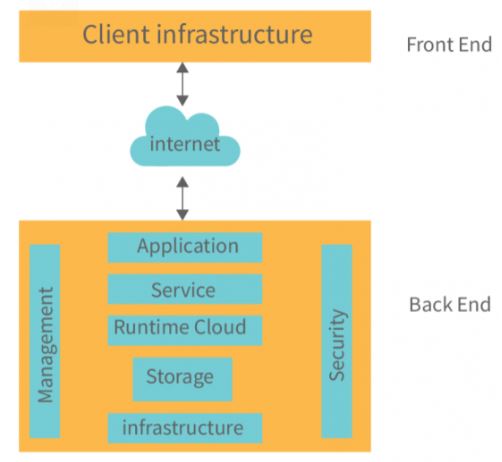Cloud Computing - Architecture
Cloud computing architecture refers to the structure and components of a cloud computing environment. It encompasses the various layers and building blocks that make up a cloud infrastructure, allowing organizations to deliver and consume cloud services.
Cloud computing architecture is divided into the following two parts.
- Front End
- Back End
The below diagram shows the architecture of cloud computing.

1. Front End
The front end refers to the client part of cloud computing system. It consists of interfaces and applications that are required to access the cloud computing platforms, Example - Web Browser.
2. Back End
The back End refers to the cloud itself. It consists of all the resources required to provide cloud computing services. It comprises of huge data storage, virtual machines, security mechanism, services, deployment models, servers, etc.
Components of Cloud Computing Architecture
There are the following components of cloud computing architecture -
1. Client Infrastructure
Client Infrastructure is a Front end component. It provides GUI (Graphical User Interface) to interact with the cloud.
2. Application
The application may be any software or platform that a client wants to access.
3. Service
A Cloud Services manages that which type of service you access according to the client’s requirement.
Cloud computing offers the following three type of services:
- Infrastructure as a Service (IaaS) - This layer provides virtualized computing resources, such as virtual machines (VMs), storage, and networking. Users can provision and manage these resources while retaining control over the operating system and applications.
- Platform as a Service (PaaS) - PaaS offers a platform and development environment that abstracts the underlying infrastructure. Developers can focus on coding and deploying applications without managing the infrastructure components.
- Software as a Service (SaaS) - SaaS delivers software applications over the internet on a subscription basis. Users can access and use the software without worrying about installation, maintenance, or infrastructure management.
4. Runtime Cloud
Runtime Cloud provides the execution and runtime environment to the virtual machines.
5. Storage
Cloud storage services provide scalable and durable storage solutions for data, including object storage, file storage, and block storage.
6. Infrastructure
It provides services on the host level, application level, and network level. Cloud infrastructure includes hardware and software components such as servers, storage, network devices, virtualization software, and other storage resources that are needed to support the cloud computing model.
7. Management
Tools for monitoring performance, managing resources, and optimizing cloud deployments are crucial for maintaining and optimizing cloud environments.
8. Security
These services enhance cloud security through features like authentication, authorization, encryption, and threat detection.
9. Internet
The Internet is medium through which front end and back end can interact and communicate with each other. Cloud networking services include virtual networks, load balancers, firewalls, content delivery networks (CDNs), and more to ensure efficient communication between cloud resources.
Next
